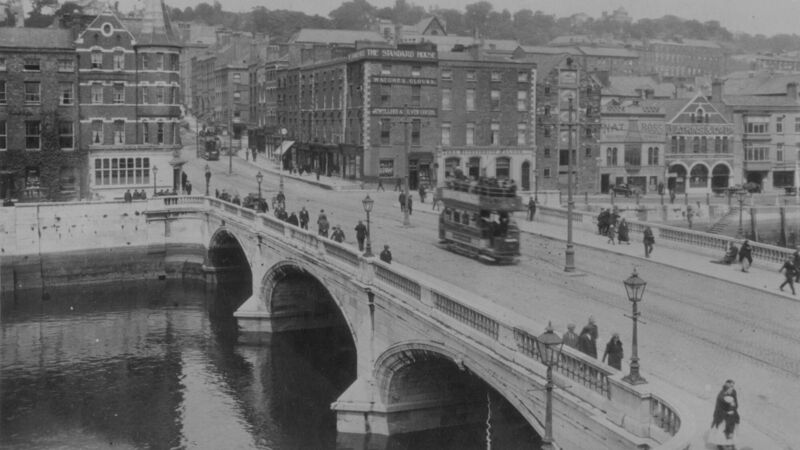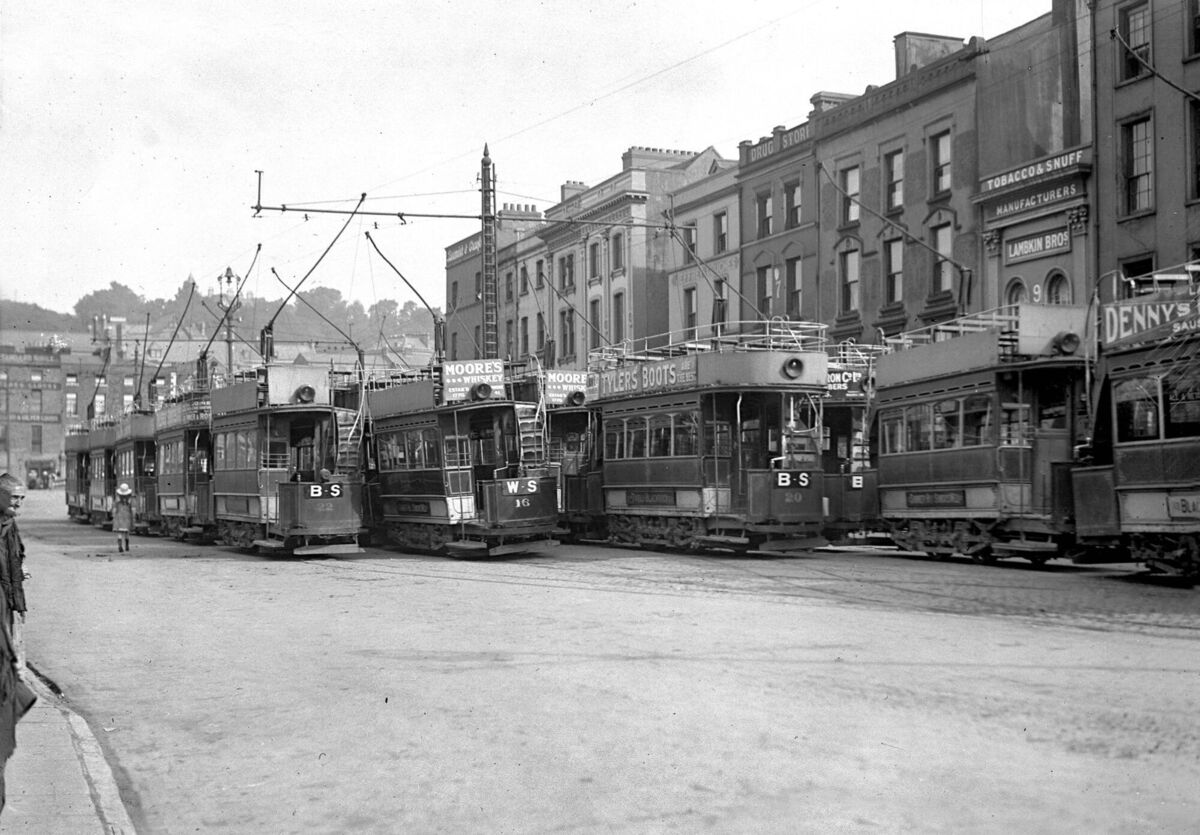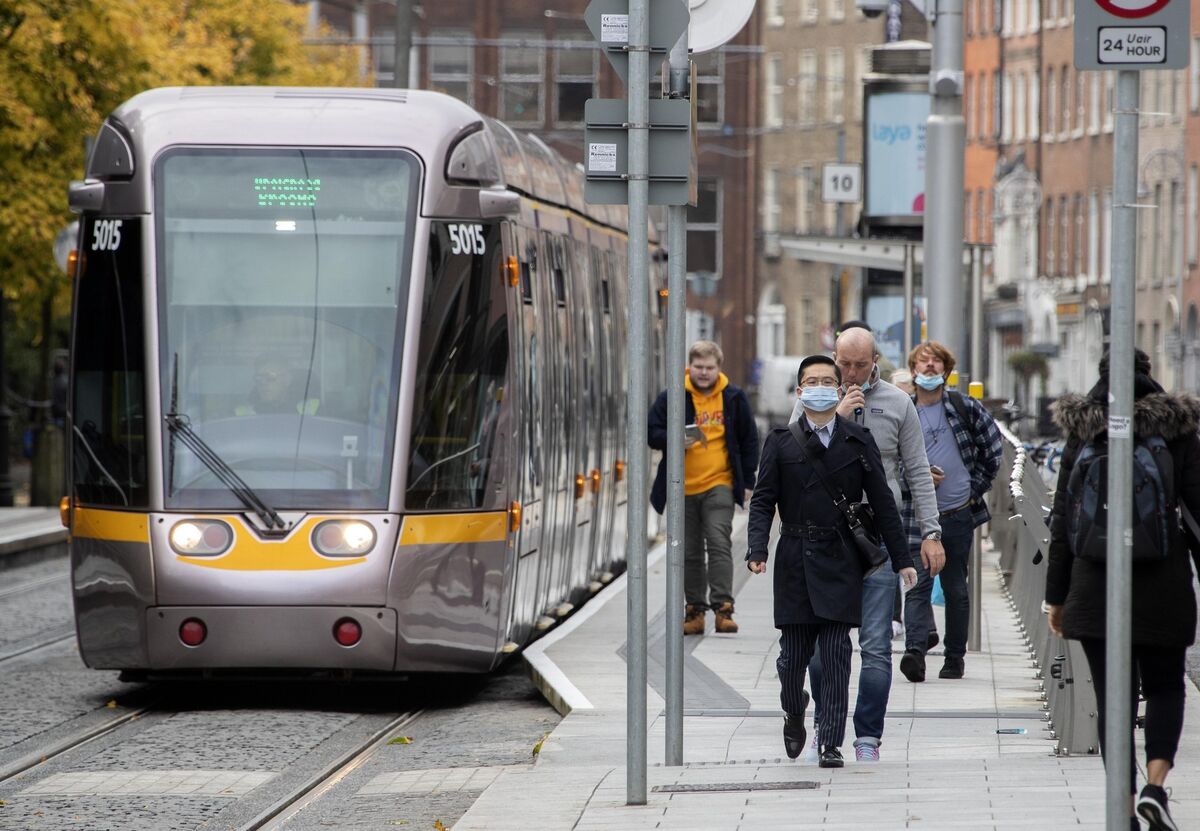Michael Moynihan: Back on track - Be wary when Cork light rail system talk comes around

A tram crosses the bridge in Cork City in 1930. (Photo by Central Press/Getty Images)
During the week a pal forwarded a clip of film showing Cork from over a century ago, a clip focusing on one particular part of the city and one particular activity.
You may have seen it — silent images which show an old tram rattling noiselessly along MacCurtain Street, when it was still King Street (and going the wrong way, traffic nerds) before it makes a sharp turn down Bridge Street and the vista of Patrick Street opens up. You can’t help urging the cameraperson to pan left to show us Merchant’s Quay, but it’s straight ahead all the way.
There’s something touching about clips like that in and of themselves — your columnist likes to confound the image abroad of him as a heartless cynic (image? - ed) by pointing to the kiddies gamboling along the footpath and pondering how all of them got on as the century rolled past, before eventually shuffling off this mortal coil.
Anything to keep the energy up. You know my form.
If you cast around online there’s an equally entertaining few seconds that show the Muskerry Light Rail trundling along towards the city having made the turn past Ballincollig (if my geography is correct the Angler’s is off to the right, somewhere, of the spot being filmed).
My attention is always caught by one of the railway officials in said clip, who seems to have escaped from his normal posting, under the word ‘officious’ in the nearest dictionary, as he bounces along, his impressive moustache the last distinguishing feature visible as he recedes into an oddly dusty middle distance.
I have now conflated those live-action clips with another image that surfaced in the shallows of social media in recent weeks.

This is far more recent, a still picture which shows a CIE train making its way along what is now the South Link Road which divides Turner’s Cross from the Douglas Road: that old-fashioned livery, best described as tired rust and sad black, makes the train stand out as it races along a track that’s bounded on all sides by ordinary back gardens.
I mention these images because a recent trip down to Blackrock Pier drew my research assistants’ attention to the odd tracks embedded in the cobbles at the traffic lights outside the Ursuline Convent.
When I said they were either the actual tram lines or a facsimile of same reproduced for heritage purposes my research assistants asked the most obvious question imaginable.
“Why did they get rid of a tram? That would have been cool.”
Cool is certainly the word. Not to mention cheap, green, user-friendly, characterful and enjoyable. But the trams went, and they went a long time ago.
The upside, though, is that we now enter a genuinely enjoyable season round of having a Cork light rail system dangled in front of us every few years.
Whenever it suits politically, Leesiders can anticipate a leak or two about the prospect of a localised train system which is just a couple of years away from realisation but which, in reality, will never actually materialise.
A little like being teased with the Olympics but with a decision never actually being made, even though it seems within reach time after time. A kind of Olympisisyphus, if you’ll allow the pretentiousness.
On the bright side, this allows me to introduce one of my favourite war stories from the period of my life I spent working in Leinster House.
At one stage I was present at an Oireachtas committee hearing which was dealing with the proposal which would in time be known as the Luas.
The hearing took place so long ago that no part of the Luas had actually been built, and this meeting was giving serious consideration to building the whole system underground, but this particular option was held up because of uncertainty about how hard the rocks under Dublin actually were.

There was a surreal edge to much of these discussions, one which is a lot funnier in retrospect, but this particular meeting came to a sudden end when one engineer chipped in with a definitive contribution.
The engineer had been at a similar meeting of the same Oireachtas committee just over a year previously, he said. It was a meeting which had been debating much the same topic.
However, in the intervening period a smaller city in Spain had considered, advertised, costed and built an extension to its existing light rail system.
It put everything in context, as the saying goes. Though in fairness, I think the second biggest take-away at this meeting came courtesy of a TD who said that in the London Underground the clay surrounding the tunnels was so soft you could stick your finger right into it. So at least there was some kind of lesson in the afternoon.
Cork city is not alone in lamenting the absence of what was once a thriving rail system, of course.
You go as far as Bantry or Baltimore and you can identify the remnants of transport lines that would be transformative if they still existed.
(Go even further: last summer yours truly chatted to a man in south Kerry who was on the last train that left Cahirsiveen as the rail system in that part of the world closed down.) Where did this disdain for public transport come from, anyway, this burning need to eradicate a system which linked the four corners of the country?
I sometimes wonder if it was an infection that came drifting from the west. One of your columnist’s favourite reads is by Robert Caro, one of the greatest historical/biographical/political books ever written.
It tells the story of Robert Moses, the man who built most of New York’s bridges and highways between the twenties and the sixties — the automobile age.
Moses built hundreds of miles of highways and roads to facilitate the car — or, to be more specific, the middle-class car owner. The gates of some of the entrances to public beaches were deliberately built too low for ordinary transit buses to access, for instance, simply to keep poorer people out.
An imaginative approach could have blended public transit with private transport needs, but Caro points out: “When Robert Moses came to power in New York in 1934, the city’s mass transportation system was probably the best in the world. When he left power in 1968 it was quite possibly the worst.” That’s a familiar enough feeling. I certainly have to confess that when struggling to get through MacCurtain Street on a wet day, with the traffic funnelling from three lanes into two (or is it one?), or trying to pick a way through the options leading out of Douglas village, the old tram system sounds pretty attractive.
It’s probably unfair to call out the urban planners of thirties Cork for their short-sightedness when their equivalents in the Big Apple were showing even less imagination with bigger budgets and more wide-ranging powers.
But this occasional reference to the possibility of a Cork light rail system is something everyone needs to be on their guard against. It’s only a short step from that chimera to another favourite memory of my Oireachtas committee years.
To wit, the proposal to build a tunnel under the sea from Ireland to Britain along the lines of the Channel Tunnel.
But that’s another story.












